Ever stared at your garden and wondered which wood makes the best bed? Dive in, and let’s unearth the secret together!
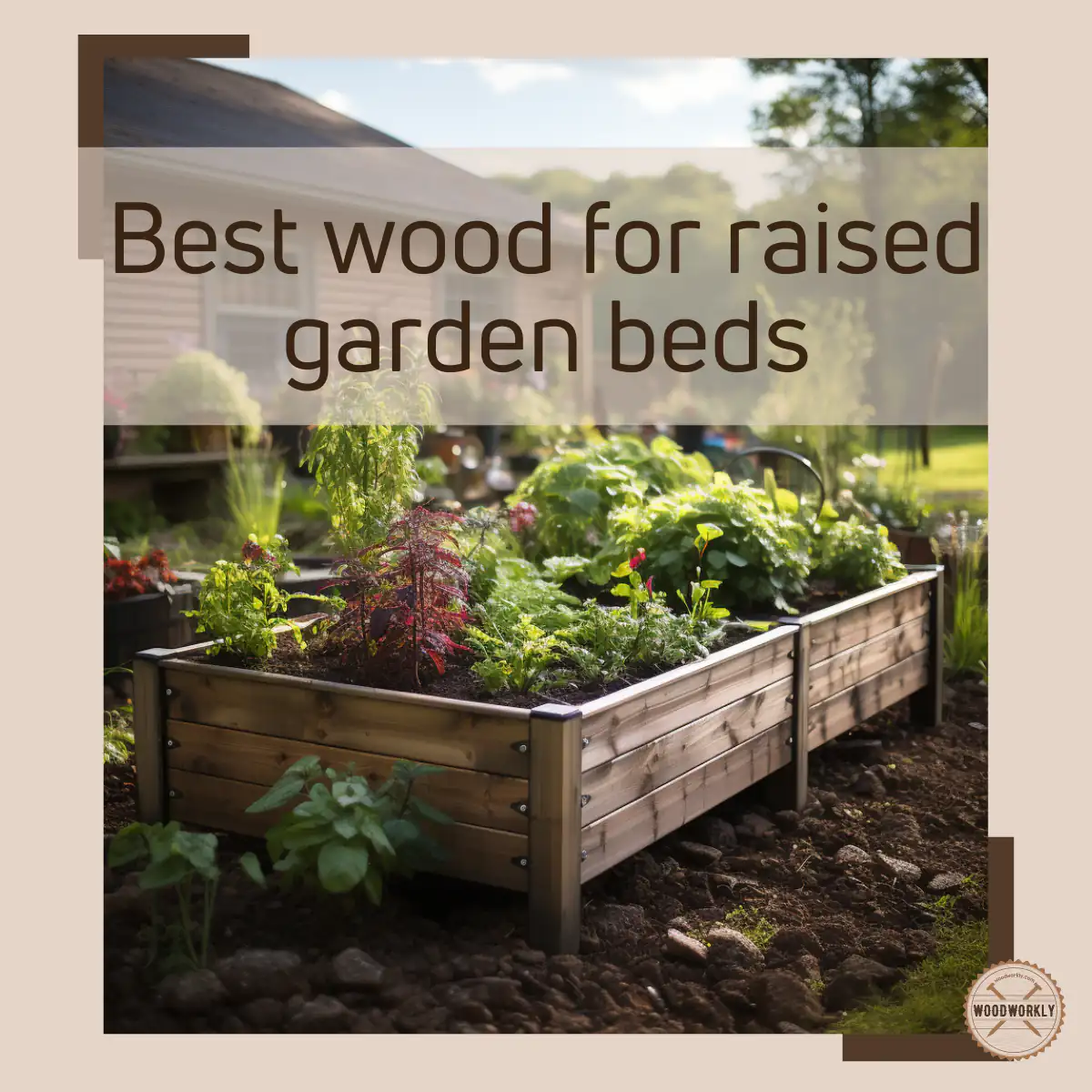
Raised garden beds have become a popular choice for gardeners. Their high manageability and ability to prevent soil erosion make them preferred over in-ground gardens.
As a woodworker who gardens as a hobby, I considered building wooden raised garden beds myself. However, I was unsure about which types of wood to use.
After conducting research and consulting with gardening experts, I gathered a wealth of useful information.
Based on that, here are the Best wood for garden beds:
- Cedar
- Redwood
- Juniper (rustic-looking)
- Chestnut
- Yew
- Pine
- Catalpa
- Douglas Fir
- Cypress
- Hemlock
- Spruce
- Black Locust
- Black Walnut
- White Oak
- Pressure-Treated Wood
But there’s a lot more you need to know!

So, in this article, I’ll explore the world of garden beds to find out the best wood for garden beds and discuss each one of them in detail with their qualities and drawbacks as well.
Furthermore, I’ll discuss the woods to avoid for garden beds and answer some frequently asked questions as well.
So, let’s get going!
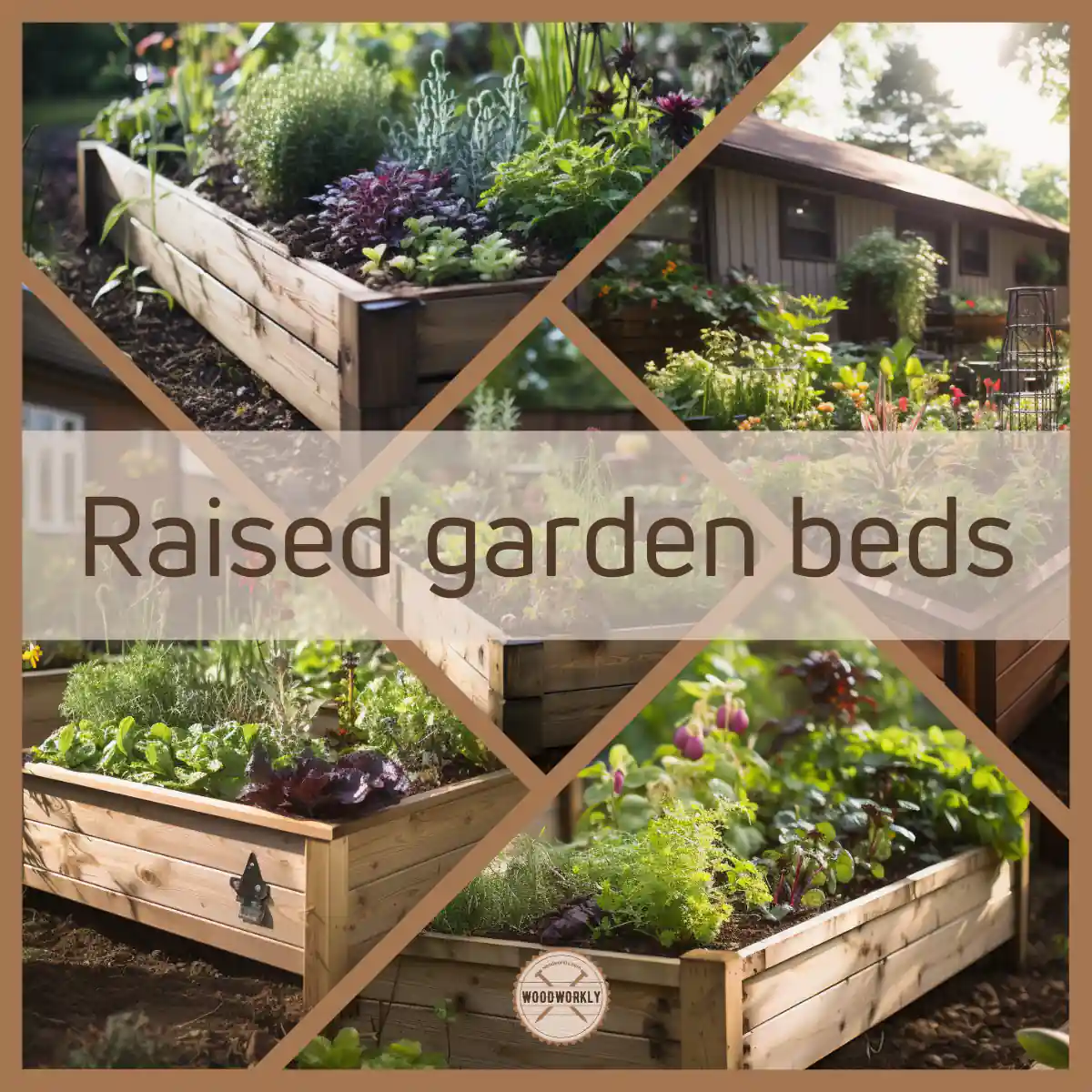
1. Cedar
Cedar is considered one of the best woods for garden beds. Western Red Cedar and Alaskan Yellow Cedar are popular options to make garden beds.
Here’re the qualities of Cedar that make it perfect for garden beds,
- Natural rot resistance
- High water resistance
- Decay resistant
- Beautiful appearance
- High stability
So, let’s talk about each of those qualities of Cedar in detail to know why it’s considered an excellent wood for garden beds.
Natural Rot-Resistance
Cedar is naturally rot-resistant and doesn’t need any chemical treatments.
Because of its natural rot-resistant ability, Cedar garden beds can easily last for more than a decade or longer under any climate.
High Water Resistance
It has natural water resistance which is so much important for outdoor applications like garden beds.
Decay Resistant
Red Cedar has a natural resistance to insect attacks. Cedar has chemical oil that protects the wood from insect attacks.
Therefore, Cedar is decay resistant and can withstand insect attacks.
Beautiful Appearance
Cedar is a type of wood that becomes better with age. When you leave the Cedar garden bed outside for one-two years, you’ll notice it changes into beautiful silver or grey color shade.
This gives an aesthetically attractive look to your garden bed.
High Stability
Cedar is a strong wood with good dimensional stability. Because of its great strength, Cedarwood garden beds can last around 30 -40 years.
Those are the main qualities that Cedarwood has which make it perfect for garden beds.
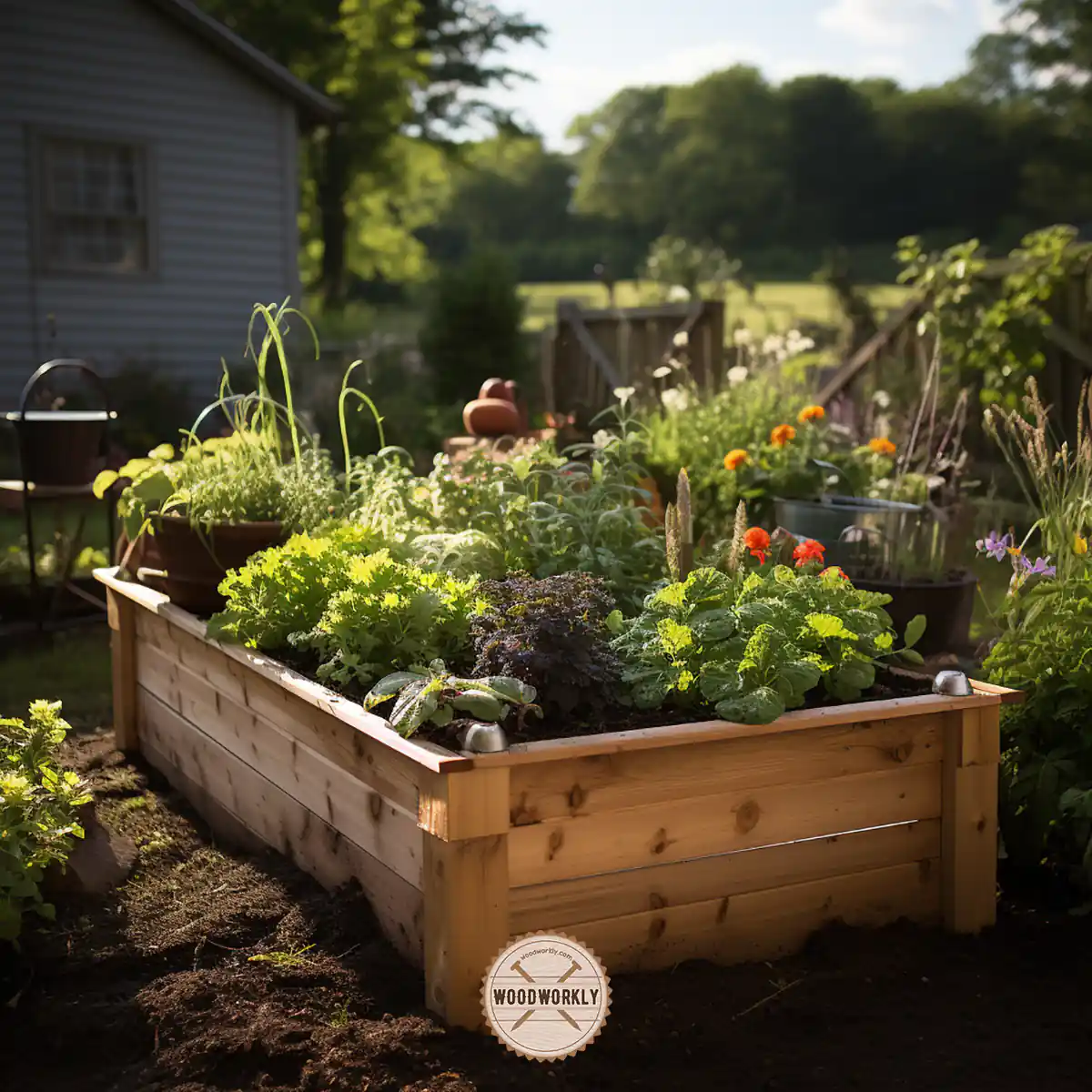
Pros and Cons Of Using Cedar for Raised Garden Beds
Let’s summarize all the important details to find out what are the pros and cons of Cedarwood for making garden beds.
| Pros | Cons |
| Rot-resistant | Expensive |
| Decay resistant | Softwood (Less strong than hardwoods) |
| Water-resistant | Require high maintenance |
| High stability | Flammable |
| Attractiveness | Unable to keep the same color over time |
| Durability |
As you can see Cedar has a natural resistance to decay, pests, and elements. Cedar has a natural oil that protects the wood from water, decay, and bugs.
This makes Cedar unique and different than many other wood types.
2. Redwood
Redwood is a popular wood that is commonly used for garden beds. Redwood is plentiful and able to make high-quality garden beds that last for more than a decade.
Here’re the qualities of Redwood which make it perfect for garden beds,
- Decay resistant
- Rot-resistant
- Durable
So, let’s discuss each of those qualities of Redwood in detail.
Decay Resistant
Redwood has natural decay resistance. Therefore, garden beds made of Redwood can easily withstand insect attacks and weathering.
This gives Redwood garden beds the ability to sit in or around for years without decaying or composting.
Rot-Resistant
Redwood has an oil produced by itself which helps the wood to prevent from rotting. Therefore, garden beds made of Redwood can last up to 20 years.
Durable
Even though Redwood is considered softwood, its natural tannins make the wood highly durable. It has the ability to repel rot and termites.
Because of having high tannin content Redwood garden beds can last longer than Cedar garden beds.
Those are the main qualities of Redwood that make it perfect for garden beds.
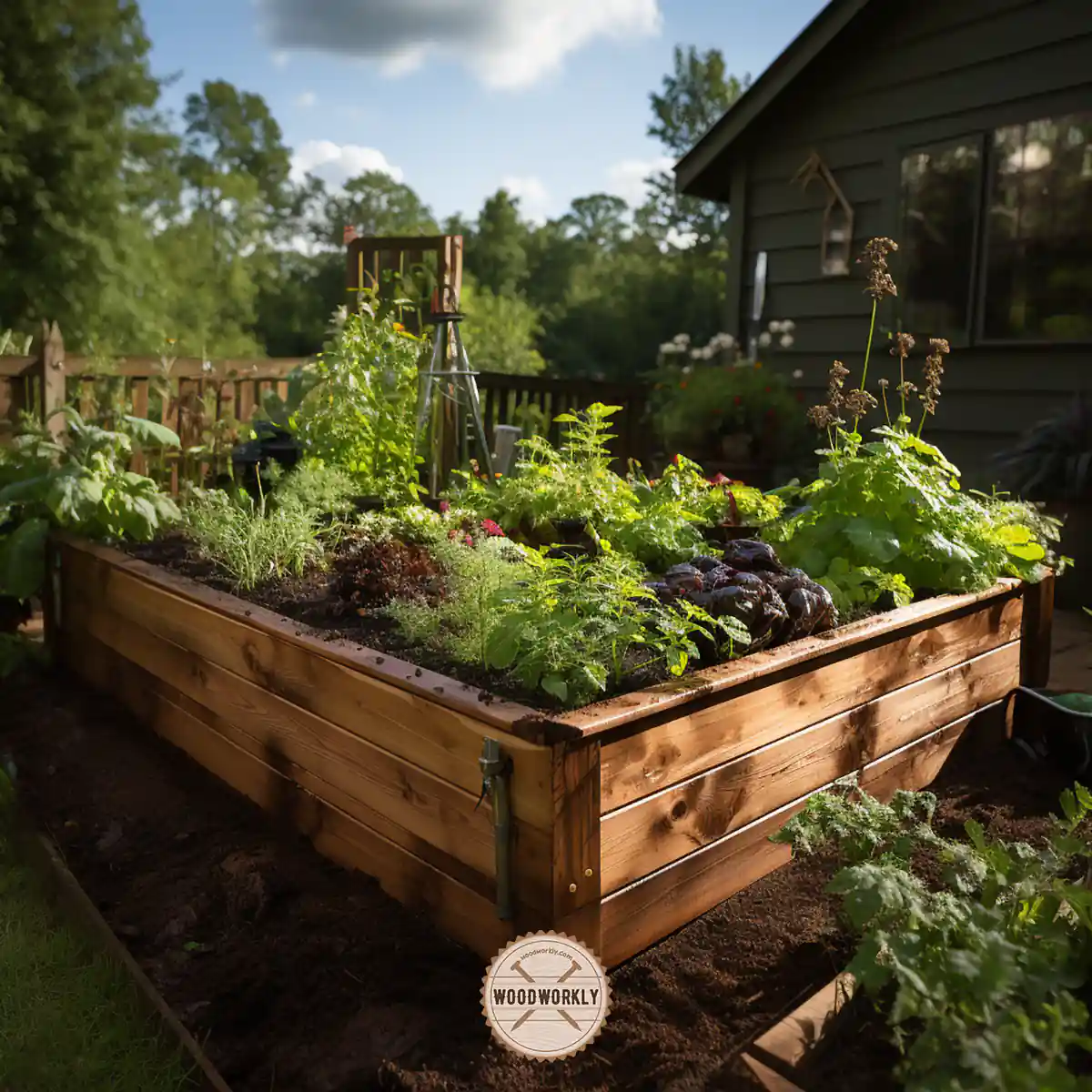
Pros and Cons Of Using Redwood for Raised Garden Beds
So, let’s see what the pros and cons of Redwood are you’ll get by using Redwood to make garden beds.
| Pros | Cons |
| Decay resistant | Need proper finishing because of being a softwood |
| Durable | Need high maintenance |
| Rot-resistant | Expensive |
| Lightweight | |
| Great for outdoor projects |
So, let’s find out what makes Juniper great to make your next garden bed project.
3. Juniper (Rustic-Looking)
Rustic-looking Juniper is great to use for making garden beds. Juniper is an excellent choice for any outdoor woodworking project because of its strength and durability.
Here’re the reasons that make Juniper good for garden beds,
- Affordable
- Rot-resistant
- Environmentally friendly
So, let’s discuss them in detail.
Affordable
By using rustic-looking Juniper, you can get mostly the same qualities as Cedar and Redwood give, by spending less amount of money.
When making garden beds usually need a higher number of wood pieces than we use to make furniture.
Therefore, being affordable is a plus point for choosing the right wood type for garden beds.
I personally recommend rustic-looking Juniper for one of the cheapest woods that can use for making garden beds which has exceptional qualities for the price value.
Rot-resistant
Juniper has the natural rot-resistant ability as Redwood and Cedar which makes it perfect for outdoor woodworking projects like making garden beds.
Juniper does not need and chemical infusion to keep it away from rotting because its naturally produced oils will keep the wood protected over years.
Environmentally Friendly
Juniper helps to protect ecosystems than any other wood type. The oils which keep the wood protected from rotting eventually leech out to the soil and act as a fertilizer.
Chemicals in that oil will be absorbed by plants and help them to grow well.
They have zero harmful effects on the outside world and protect the wood from weather and pests for over decades.
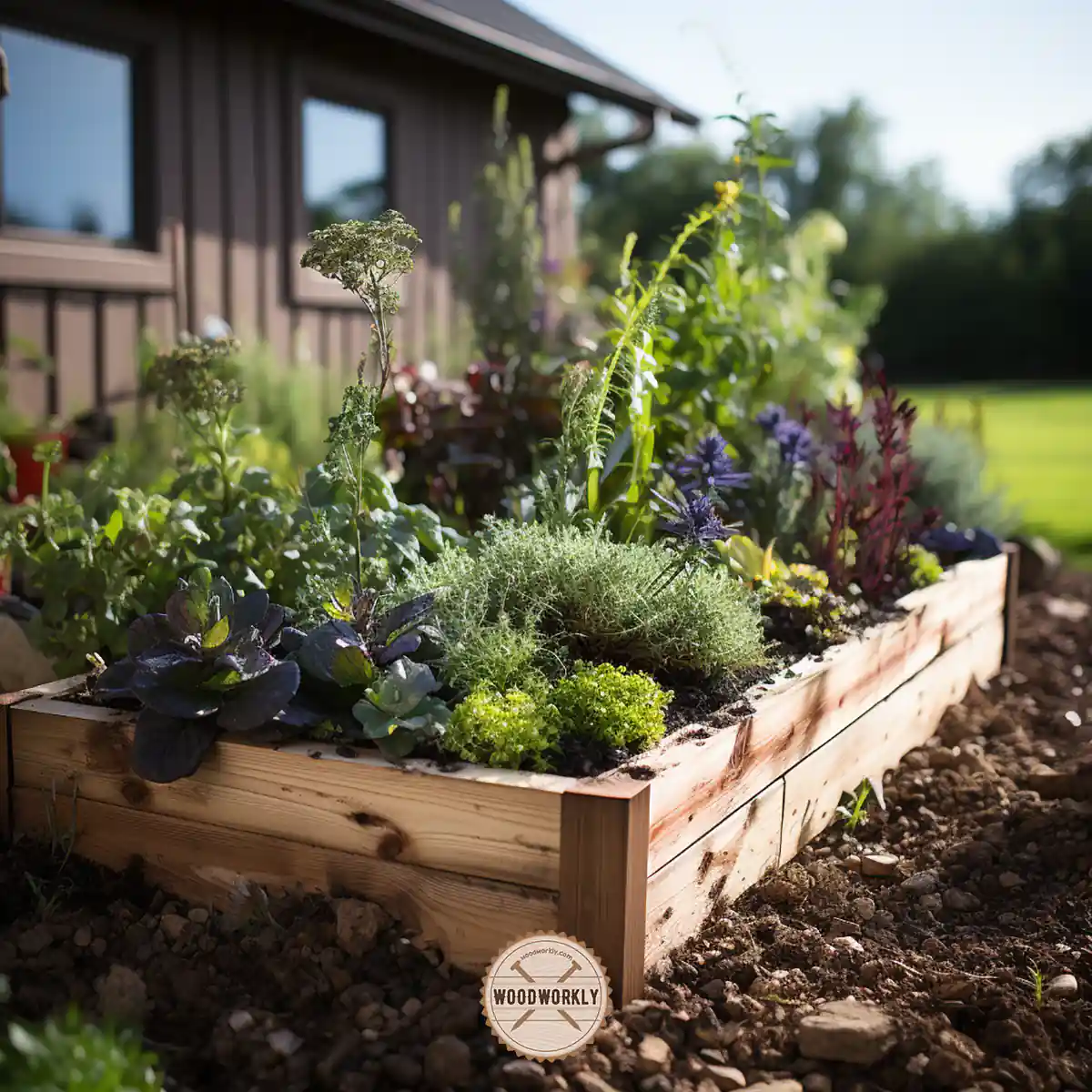
Pros and Cons Of Using Juniper for Raised Garden Beds
So, let’s summarize the pros and cons of Juniper that are important when making garden beds.
| Pros | Cons |
| Environmentally friendly | Less durable |
| Rot-resistant | Lasts less than 7 – 8. Years |
| Affordable | Tough to cut |
| Helps to grow plants | Hard to fit pieces together without gaps |
4. Chestnut
Chestnut is considered one of the best long-lasting wood that can use for a garden bed.
It has a beautiful straight grain texture that can use for any kind of woodworking purpose.
Here’re the best qualities of Chestnut wood that are important for making garden beds,
- Rot-resistant
- Easy to work with
- Beautiful appearance
Let’s discuss each of the above qualities of chestnut in detail.
Rot-Resistant
Chestnut is wood with tannins that are useful to protect the wood from weather and insect attacks.
Also, Chestnut is a hardwood with high density and its rot resistance ability is considered as its finest quality.
Easy to Work With
Making garden beds with Chestnut wood is easy because of its high workability. Chestnut glue and nails well.
Even a beginner in woodworking can make a garden bed using Chestnut without any issues due to its high workability.
Beautiful Appearance
Chestnut has attractive dark or light brown color with a rustic look. Therefore, Chestnut is popular for outdoor applications.
Its unique texture and appearance add a new color to your garden.
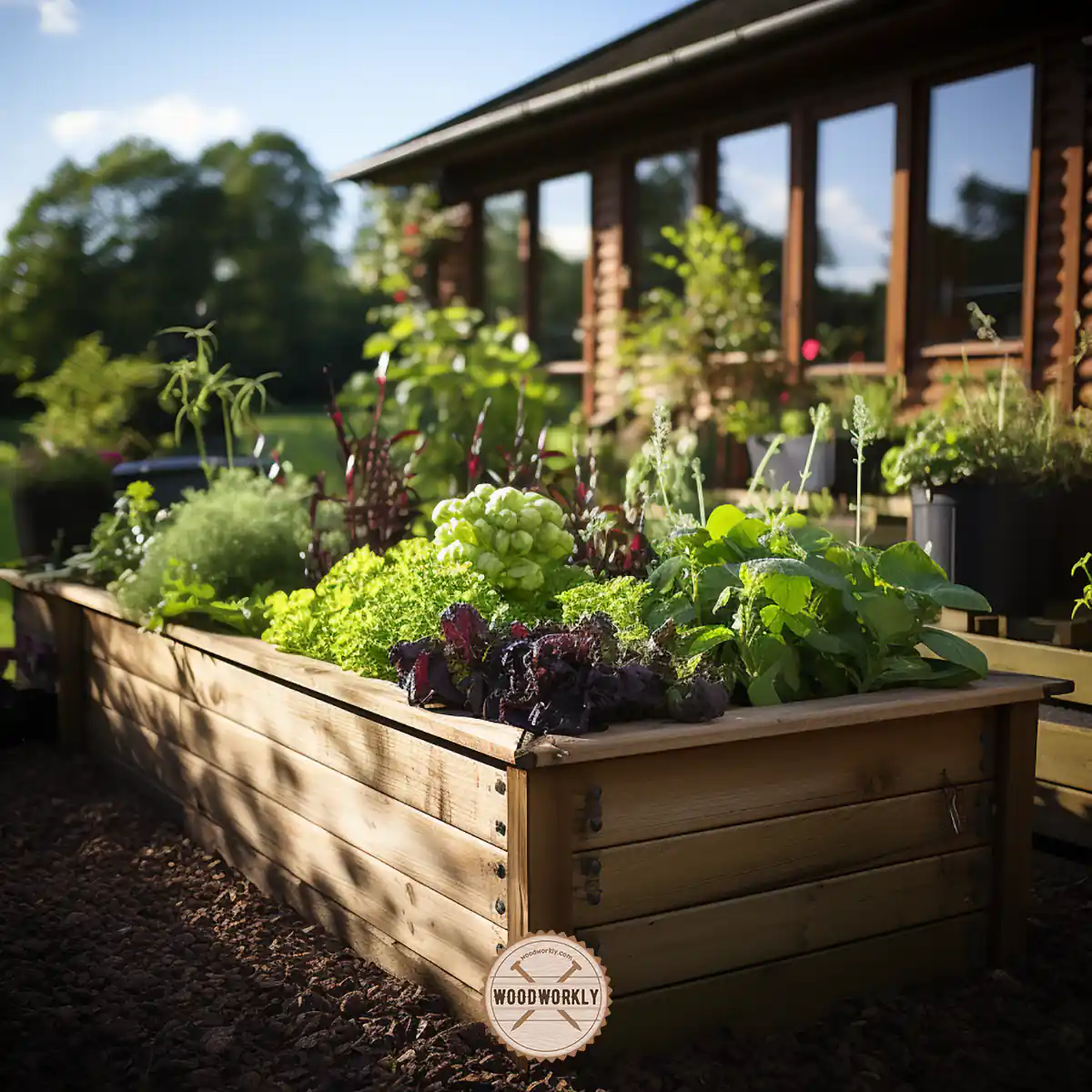
Pros and Cons Of Using Chestnut for Raised Garden Beds
Let’s summarize the pros and cons of Chestnut in making garden beds.
| Pros | Cons |
| Easy to work with | Split easily |
| Rot-resistant | Less availability |
| Beautiful appearance | |
| Not harmful for human skin or the environment | |
| Worth for the price | |
| Durable |
5. Yew
Yew is considered one of the best long-lasting wood that is perfect for garden beds. It is hard and durable wood that is commonly used for commercial purposes.
Here’re are some qualities of Yew wood, important in making garden beds,
- Appearance
- High durability
- Rot-resistant
So, let’s discuss each of the above qualities in detail.
Appearance
Yew wood has nice looking orange, brown color with straight grain.
It has a uniform texture that will add a unique aesthetic look to your garden beds. Yew wood makes attractive garden beds for sure.
High Durability
Yew wood can withstand stress, wear, and tear. It is so durable and garden beds made of Yew wood can easily last over 10 – 20 years.
Rot-resistant
Yew wood has natural rot resistance which is pretty much useful in garden beds.
It tends to withstand insect attacks and therefore Yew wood can use to make garden beds even in humid areas as well.
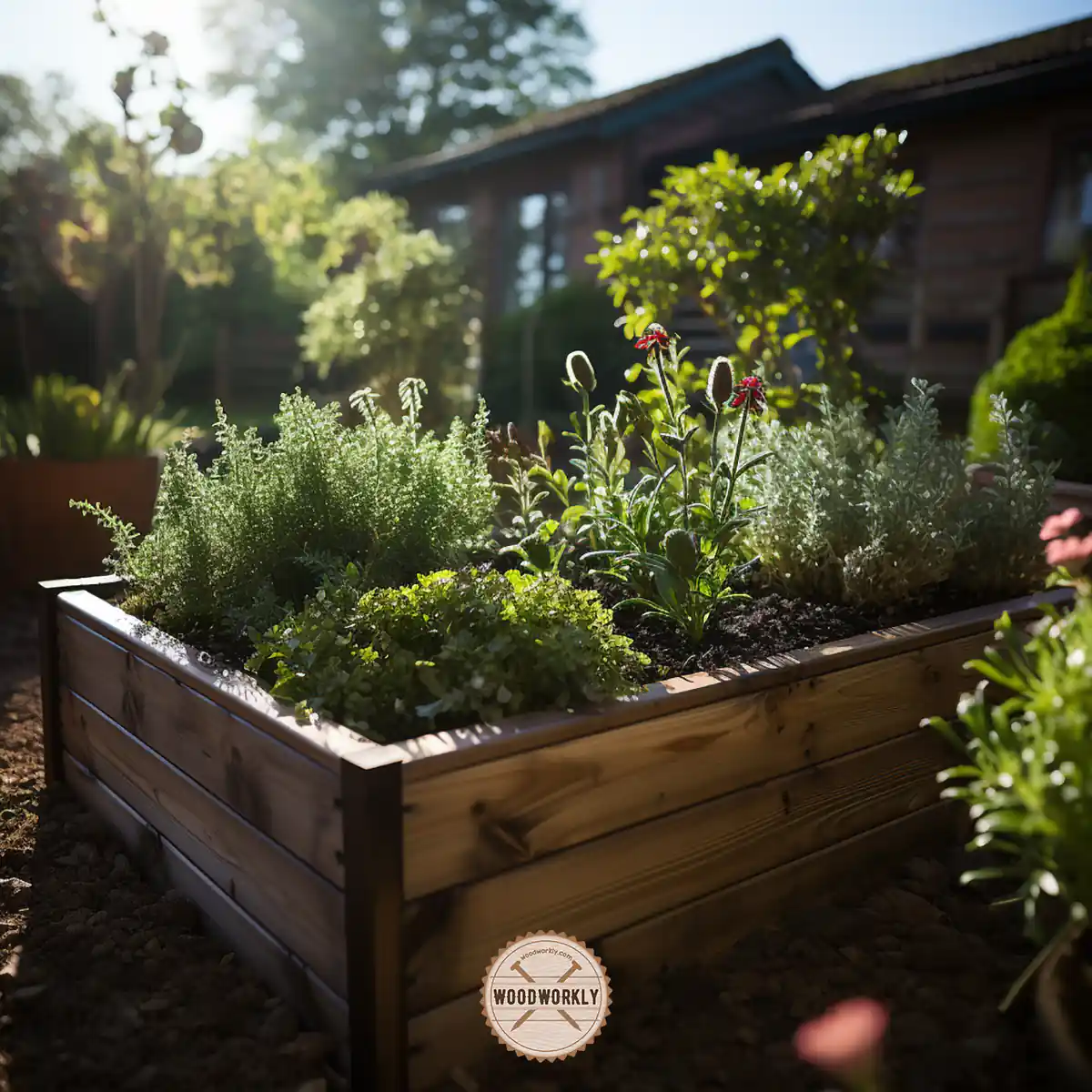
Pros and Cons Of Using Yew for Raised Garden Beds
Here’re the summarized pros and cons of Yew wood in terms of making garden beds.
| Pros | Cons |
| Rot resistance | Toxic to human skin |
| High durability | The oily surface of the wood can affect the finishes |
| Attractive |
Tip: As you can see the toxicity of Yew wood can irritate the skin, respiratory problems, and eye allergies.
So, when you’re using Yew wood to make garden beds, always wear goggles, gloves and follow safety guidelines.
Other than that, Yew is an excellent wood for garden beds.
6. Pine
Pinewood is a suitable wood for a raised garden bed. Pine is softwood with attractive wood grain, and it has many other unique characteristics which are important when making a garden bed.
Here’re some great qualities of Pinewood that are useful in garden bed making,
- Inexpensive
- Dimensional stability
Let’s discuss each of the above qualities of pine in detail.
Inexpensive
Apart from using Cedar and Redwood, most people go for Pine due to its low cost.
When you’re planning to make a huge number of garden beds, you should really care about the cost.
On those occasions, Pinewood gives exceptional qualities for the price that is useful in outdoor woodworking projects.
Dimensional Stability
Even though Pine wood is considered softwood, it has good stability that is pretty much useful in making garden beds. Pine takes manipulation with lather, saw, or router as well.
Because of its stability, it is so much easy to keep garden bed frames steady for screwing, sanding, and drilling.
If you’re a beginner in woodworking who is planning to make garden beds, Pine is a type of wood that makes you feel comfortable when using.
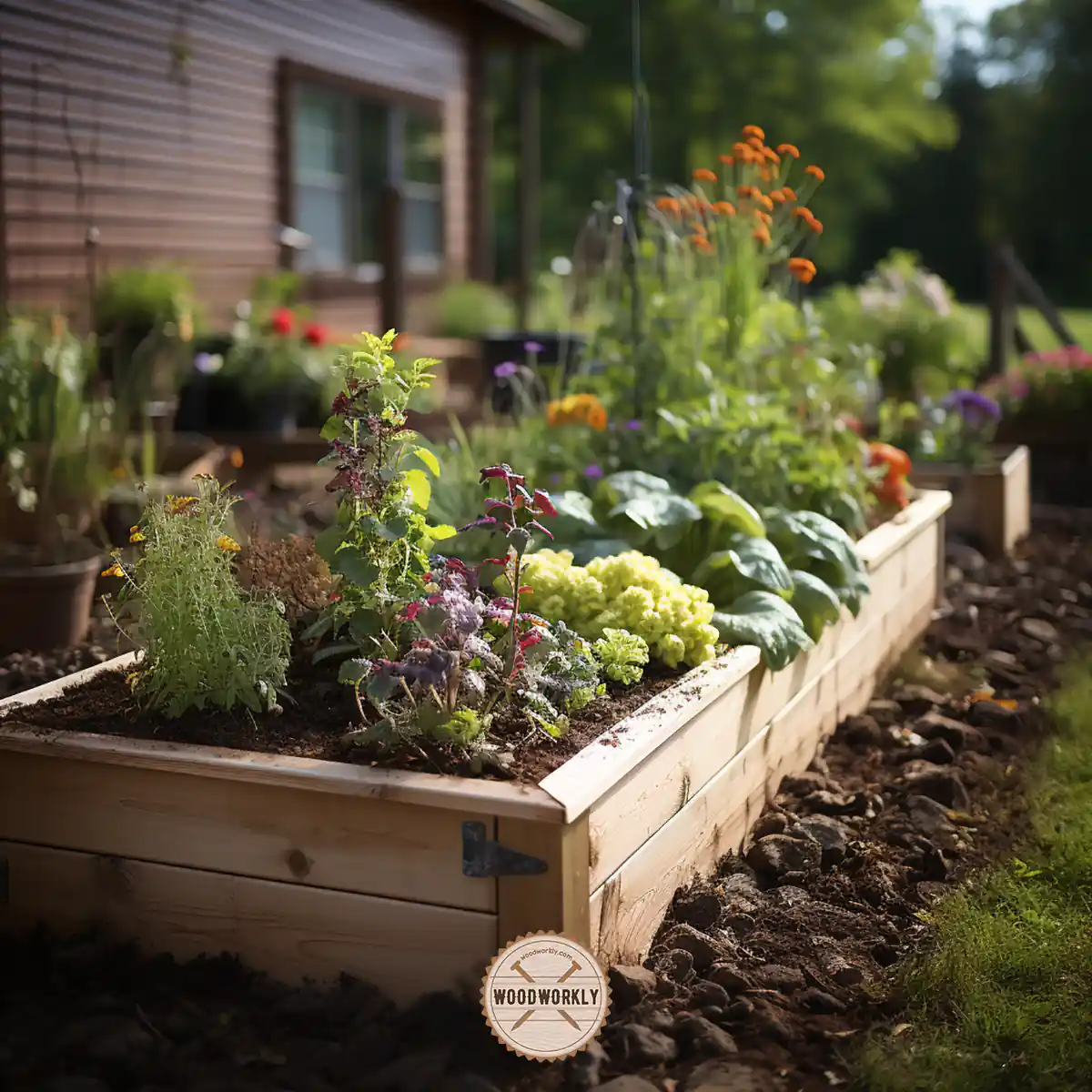
Pros and Cons Of Using Pine for Raised Garden Beds
So, let’s find out what are the pros and cons you’ll get by using Pinewood as the garden bed material.
| Pros | Cons |
| Cheap | Less resistant to moisture |
| High stability | Less rot resistant |
| Lightweight | Need to focus more on sealing and finishing |
| Attractive | Pine lasts long only for 7 – 10 years. Less than hardwoods. |
| Easy to work with | Easily get attacked by insects and pests |
As you can see, Pinewood needs to be finished with care and need good maintenance because of is a softwood.
By applying a good finishing product like sealer or paint, you’ll be able to keep Pine garden beds that last the same as Cedar and Redwood garden beds with ease.
7. Catalpa
Catalpa is an underrated hardwood with lots of exceptional qualities that are suitable to make raised garden beds.
It is used in many indoor and outdoor woodworking projects and people have gained good results with it.
Therefore, Catalpa is included under the best woods for garden beds.
Here’re some of the great qualities of Catalpa which are important in raised garden bed making,
- Dimensional stability
- Rot-resistant
- Easy to work with
Let’s discuss each of the above qualities of Catalpa wood ind etail which are improtant in amkeing rasied garden beds.
Dimensional Stability
Catalpa is dimensionally stable. Therefore, you can get the shape you want for a garden bed with ease without splitting or cracking the wood.
Because of its stability, Catalpa garden beds don’t check or twist.
Rot-resistant
Catalpa is also fallen into the rot-resistant category which is great for outdoor woodworking projects like making a garden bed.
Easy to Work With
Catalpa wood is easy to handle, screw, nail, and glue. It can easily work with hand tools and power tools.
You can get a nice and smooth crisp edge with Catalpa, which makes your garden bed more attractive and unique.
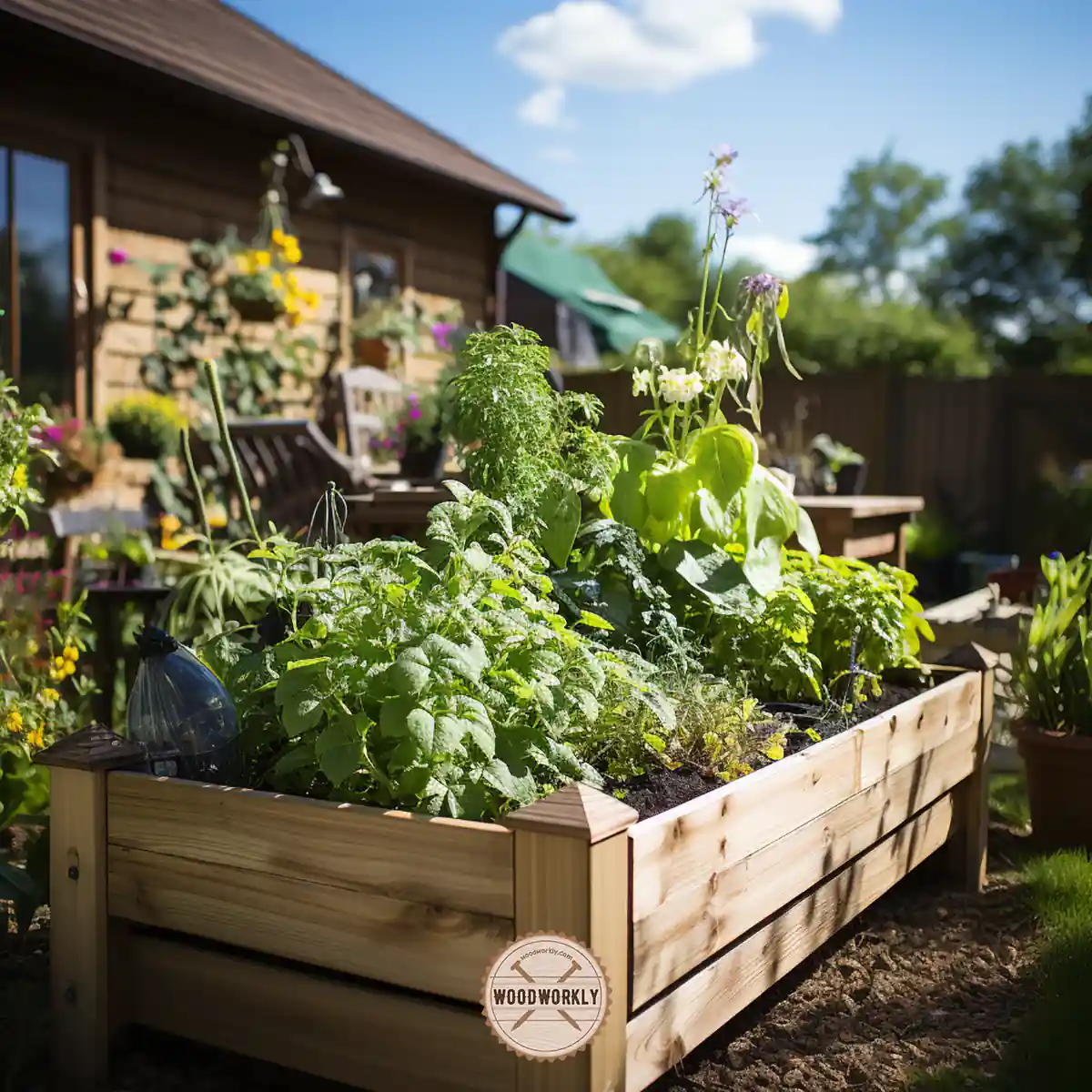
Pros and Cons Of Using Catalpa for Raised Garden Beds
Here’re the summarized pros and cons of Catalpa which are useful in making garden beds.
| Pros | Cons |
| High workability | Hard to finish due to less absorbance of Pine pored latewood and can get screen blotchiness |
| Rot-resistant | Staining is not recommended due to the muddy look |
| Dimensional stability | Less availability |
8. Douglas Fir
Douglas Fir is a suitable softwood material for raised beds. It contains no harmful chemicals, and it is an eco-friendly option to make garden beds.
Here’re some great qualities of Douglas Fir which are important in garden bed making,
- Affordable
- Long-lasting
- No chemicals
Let’s discuss each of the above qualities in detail.
Affordable
Douglas Fir is a cheap option for raised beds. You can easily get qualities for the paying price that will lead to properly made garden beds.
Long-lasting
Garden beds made of Douglas Fir can last long easily for 7 -10 years.
Therefore, in terms of durability Douglas, fir is better than most of the softwoods.
No Chemicals
Douglas Fir has zero toxicity towards the human skin and outside environment. It does not release any chemicals to the outdoor world.
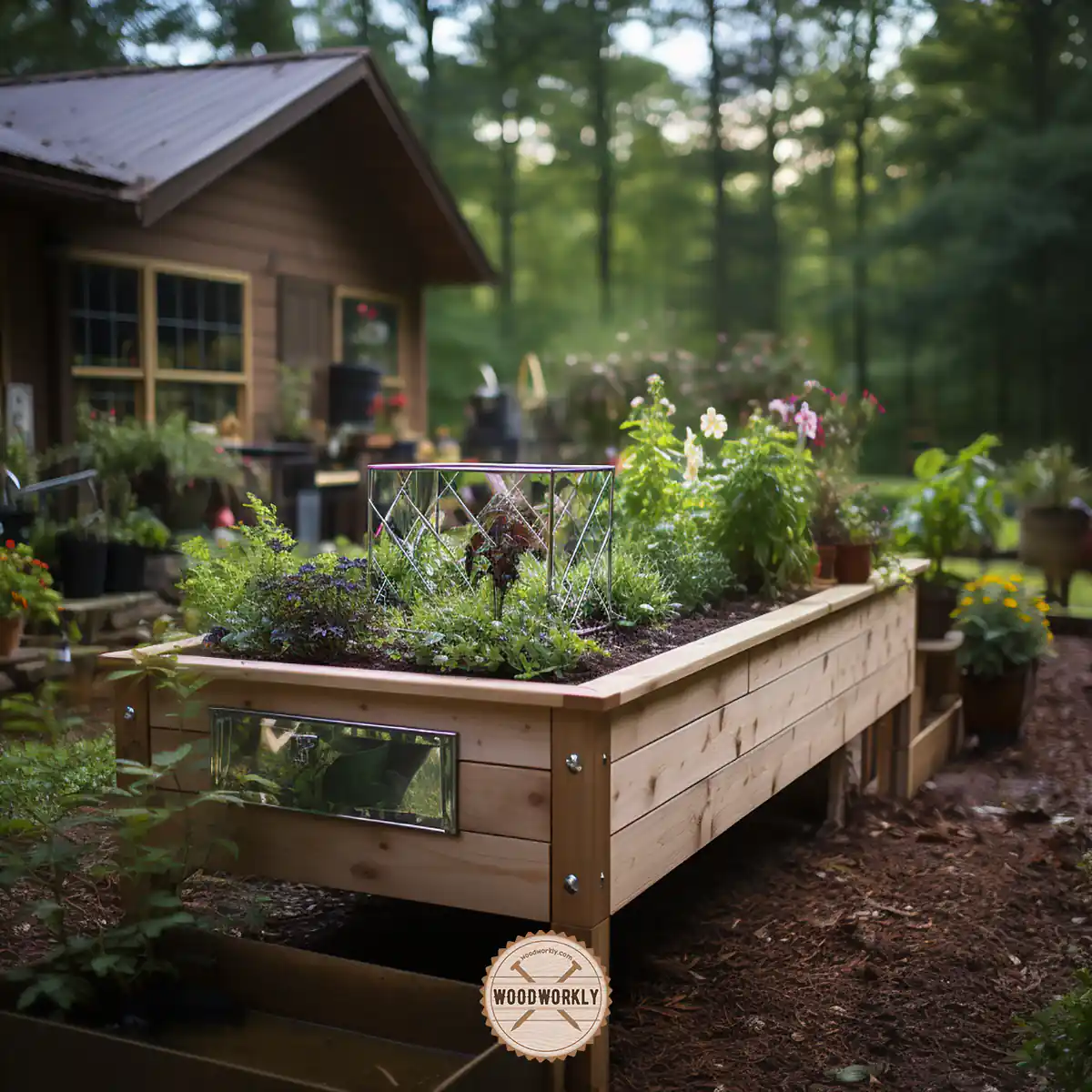
Pros and Cons Of Using Douglas Fir for Raised Garden Beds
Here’re some pros and cons of Douglas Fir in raised garden bed making.
| Pros | Cons |
| Cheaper than hardwoods | Expensive than softwoods |
| High durability | Need high maintenance |
| No harmful chemicals | |
| Has good strength | |
| Significant decay and moisture resistant |
As you can see Douglas Fir has some wonderful qualities as softwood, which make it a special component in garden bed making.
Plus, Douglas Fir takes stain so well and finishing is easy.
So, let’s talk about another best wood for garden beds and its qualities.
9. Cypress
Cypress is great to make garden beds because it can add rustic elegance to your yard.
Other than Cedar and Redwood, Cypress is also considered a top tire wood type for garden beds with lots of great qualities.
Here’re are the qualities of Cypress that make it an excellent option for rasied garden beds,
- Rot-resistant
- Long-lasting
- Easy to work with
Let’s discuss them in detail.
Rot-resistant
Cypress has the natural rot resistance, and it has more heartwood than new cousins which is harder and much more resistant to rot.
Cypress contains natural oil which helps to protect the wood from outdoor elements.
Long-lasting
Cypress garden beds last for more than a decade. It has good water resistance and can withstand attacks from insects and pests.
Easy to Work With
Working with Cypress wood is easy and fun. It has good nailing, gluing, and sanding properties.
Even a beginner in woodworking can easily catch up on techniques and methods by using Cypress wood.
You can fit Cypress wood pieces tightly without any gaps and make beautiful well-finished garden beds with a little effort.
It has good finishing qualities as well. Stain and paints hold well to the wooden surface.
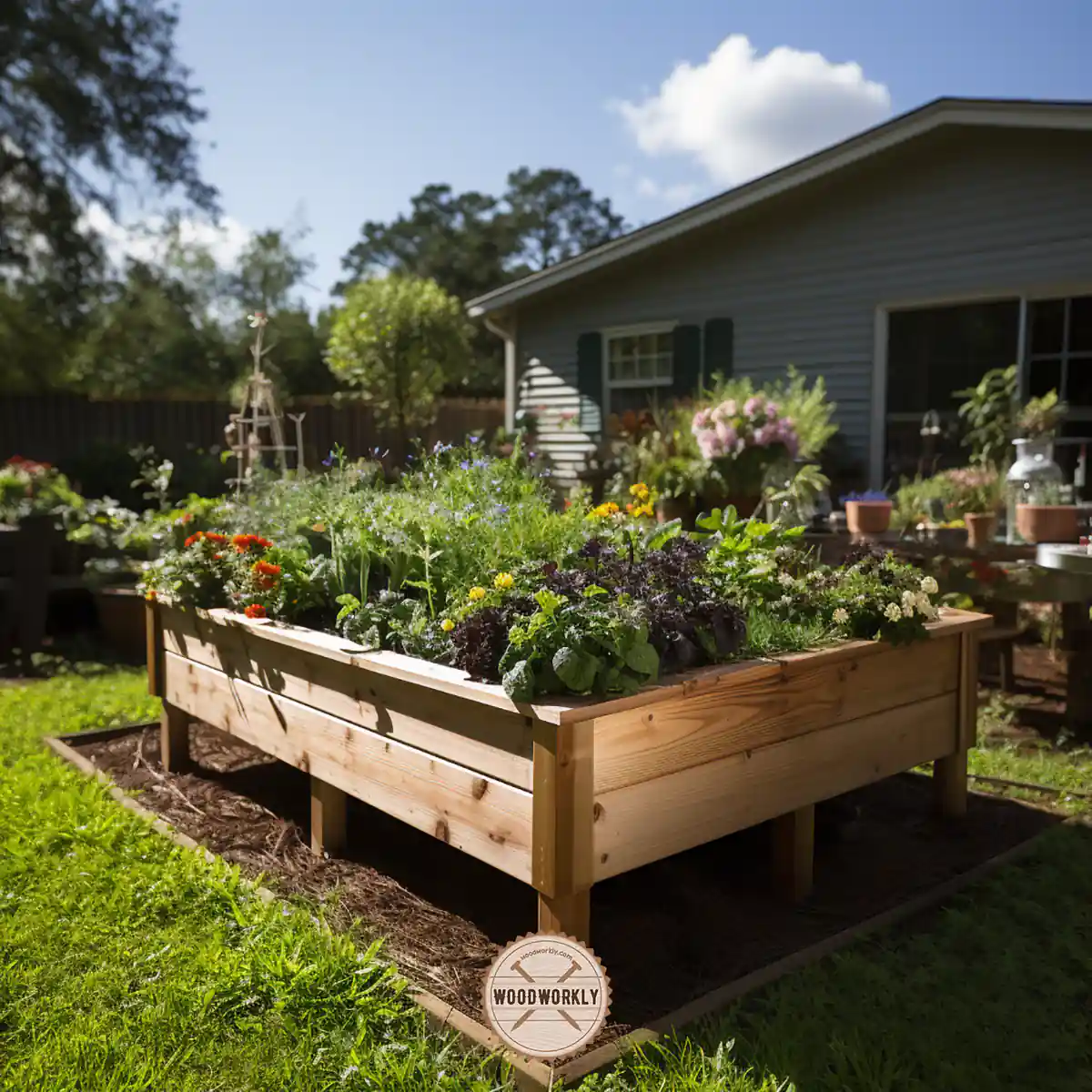
Pros and Cons Of Using Cypress for Raised Garden Beds
Here’re some pros and cons of Cypress wood which make it significantly valuable to use for garden beds.
| Pros | Cons |
| Attractive light yellowish-brown color | Toxicity (Wear gloves and mask during the process) |
| Rot-resistant | Sour odor |
| High workability | |
| Straight grain and texture | |
| Cheap |
As you can see even though Cedar and Redwood are considered the best woods, both are expensive wood types.
But Cypress is a cheap wood while providing the same number of qualities as the other two.
This makes Cypress special over any kind of wood in making garden beds.
10. Hemlock
Hemlock is hardwood lumber with a great amount of strength. Hemlock can make garden beds with good strength and more durable than most other softwood types.
Here’re some great qualities of Hemlock in garden bed making,
- High strength
- Easy to finish
Let’s discuss each of the above qualities in detail for more knoledge.
High Strength
Hemlock is a hardwood with 11,300 psi bending strength and great hardness.
If you’re looking for wood with good hardness and strength, Hemlock is the wood that I personally recommend to make garden beds.
But because of being so hard and dense, working with Hemlock is quite difficult than many other kinds of wood.
That’s the drawback of Hemlock. It is useful for rough products.
Easy to Finish
Hemlock garden beds are easy to finish. Hemlock has a smooth texture that absorbs stain so easily and therefore it gets coated well.
This will improve the appearance and the lifetime of your garden bed.
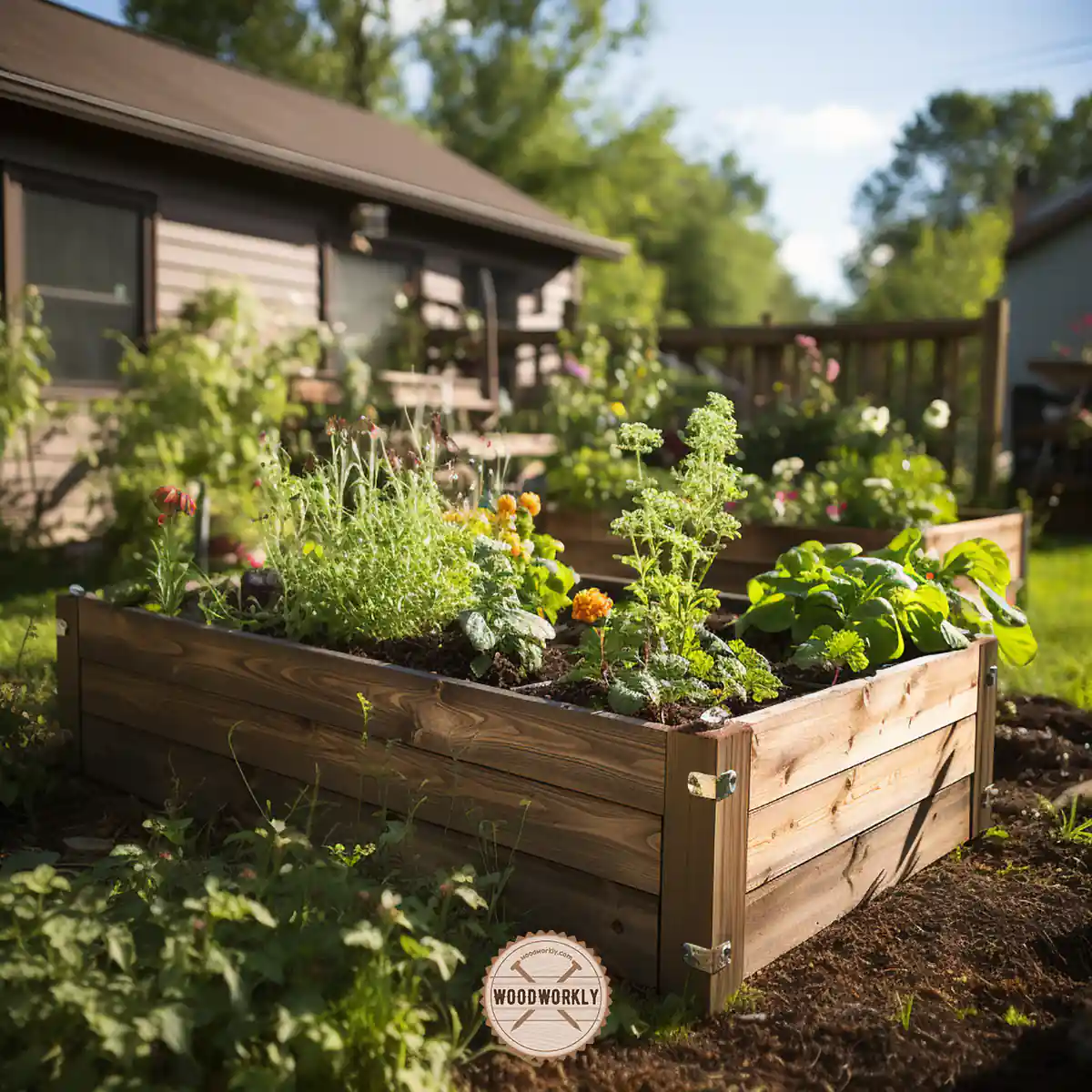
Pros and Cons Of Using Hemlock for Raised Garden Beds
Here’re some pros and cons of Hemlock wood which are important in garden bed making.
| Pros | Cons |
| The attractive reddish-brown color gives a unique look to garden beds and also the uniform texture | No decay resistance. Easy to get attacked by insects. |
| Take paint and stain so easily | Toxicity. Make sure to wear gloves and a mask when making garden beds using Hemlock wood. |
| High strength and hardness |
Hemlock wood easily gets attacked by outdoor elements like insects and moisture.
Therefore, you’ll need to focus more on the finishing part when making garden beds with Hemlock wood.
Otherwise, your whole effort will be a waste of time. so, make sure to apply a properly suitable sealer after the woodworking part is done.
11. Spruce
Spruce is known as the best wood for garden beds in terms of mobility and price. It is affordable wood and lightweight.
Therefore, handling is so much easier than working with hardwoods.
But because of being softwood, Spruce garden beds will easily get attacked by insects and pests. To prevent that Spruce woods are pressure treated before making the garden beds.
Here’re some great qualities of Spruce that make it special for making raised garden beds,
- Affordable
- Appearance
Let’s discuss above qualities in detail.
Affordable
Spruce is a cheaper option for making garden beds. But those beds will last more than 7 – 10 years.
Therefore, Spruce is more than worth the price.
You can make garden beds more than you wish by spending a very little amount of money on Spruce while gaining the finest qualities.
Appearance
Spruce has a bright color that changes into yellowish-brown color with age. Garden beds made of Spruce are easily recognizable and attractive because of this unique aesthetic color.
Also, Spruce has a clear surface with excellent structural striped grains.
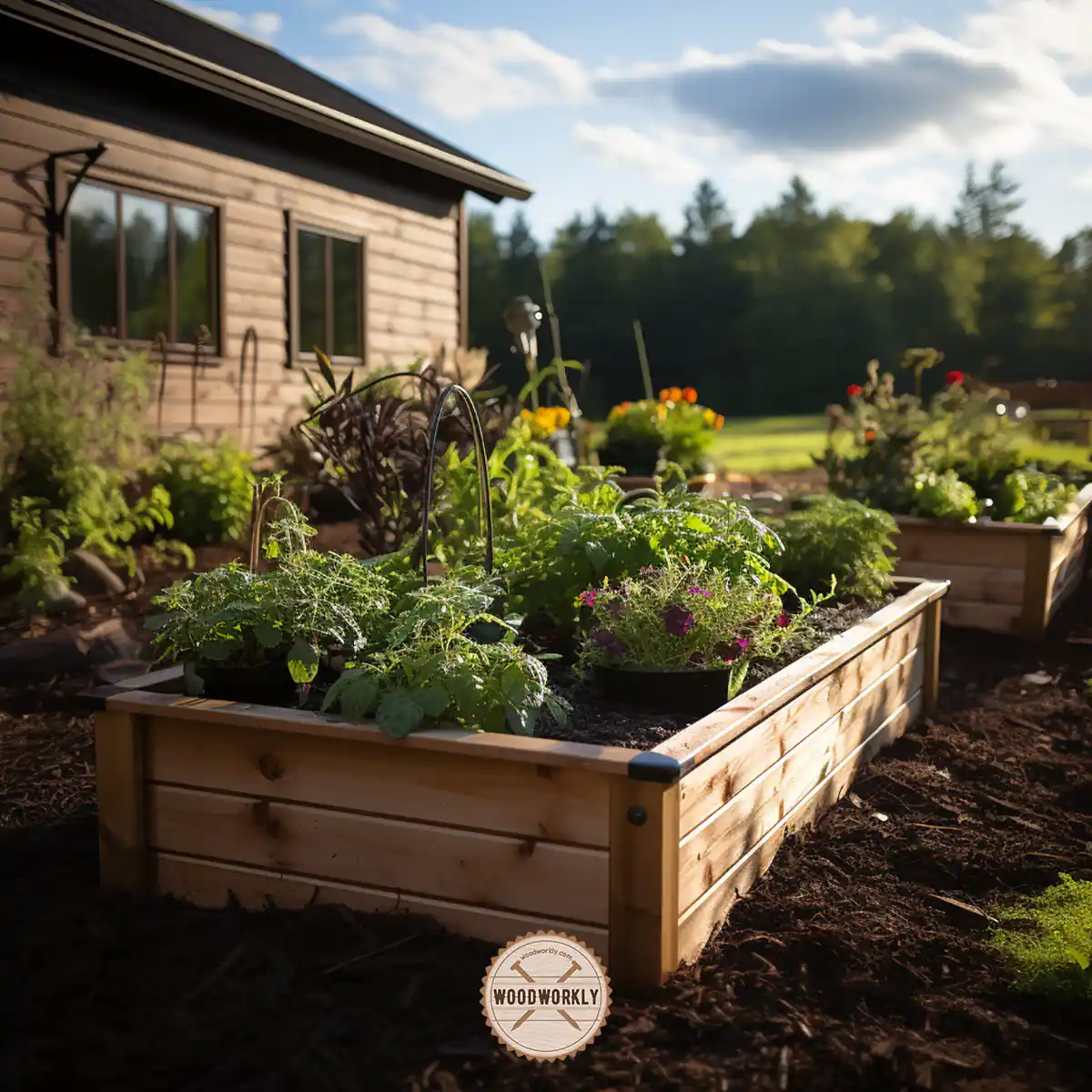
Pros and Cons Of Using Spruce for Raised Garden Beds
Let’s find out what are the pros and cons of Spruce that useful in making raised beds.
| Pros | Cons |
| Affordable | Less resistant to insects. |
| Attractive | No weather resistance |
| Lightweight | Less decay resistance |
As you can see Spruce can easily get damaged because of environmental elements such as water, moisture, and insects.
To prevent those, you should focus on finishing the wood with a suitable stain, paint, or any other sealer that protects the wood from outside by blocking the entrances.
12. Black Locust
Black Locust is a dense wood with exceptional qualities that are probably useful in making raised garden beds.
It is a medium-sized hardwood with great strength.
Here’re some qualities of Black Locust which are helpful in making garden beds,
- Highly durable
- Resistant to environmental elements
- Decay resistant
Let’s discuss the above qualities of Black locust in detail.
Highly Durable
Because of being a dense hardwood, Black Locust has great durability.
It is resistant to most environmental elements such as moisture, humidity, and insect attacks. Garden beds made of Black Locust last more than two three-decade.
Resistant to Environmental Elements
Black Locust garden beds last so long.
The wood contains a high concentration of an anti-fungal compound called taxifolin and flavonoids which prevent the wood from rotting and give protection from insect attacks.
Decay Resistant
Black Locust has natural decay resistance which helps garden beds to last long over decades.
The reason for its resistance to decay is because of having high amount of calcium oxalate.
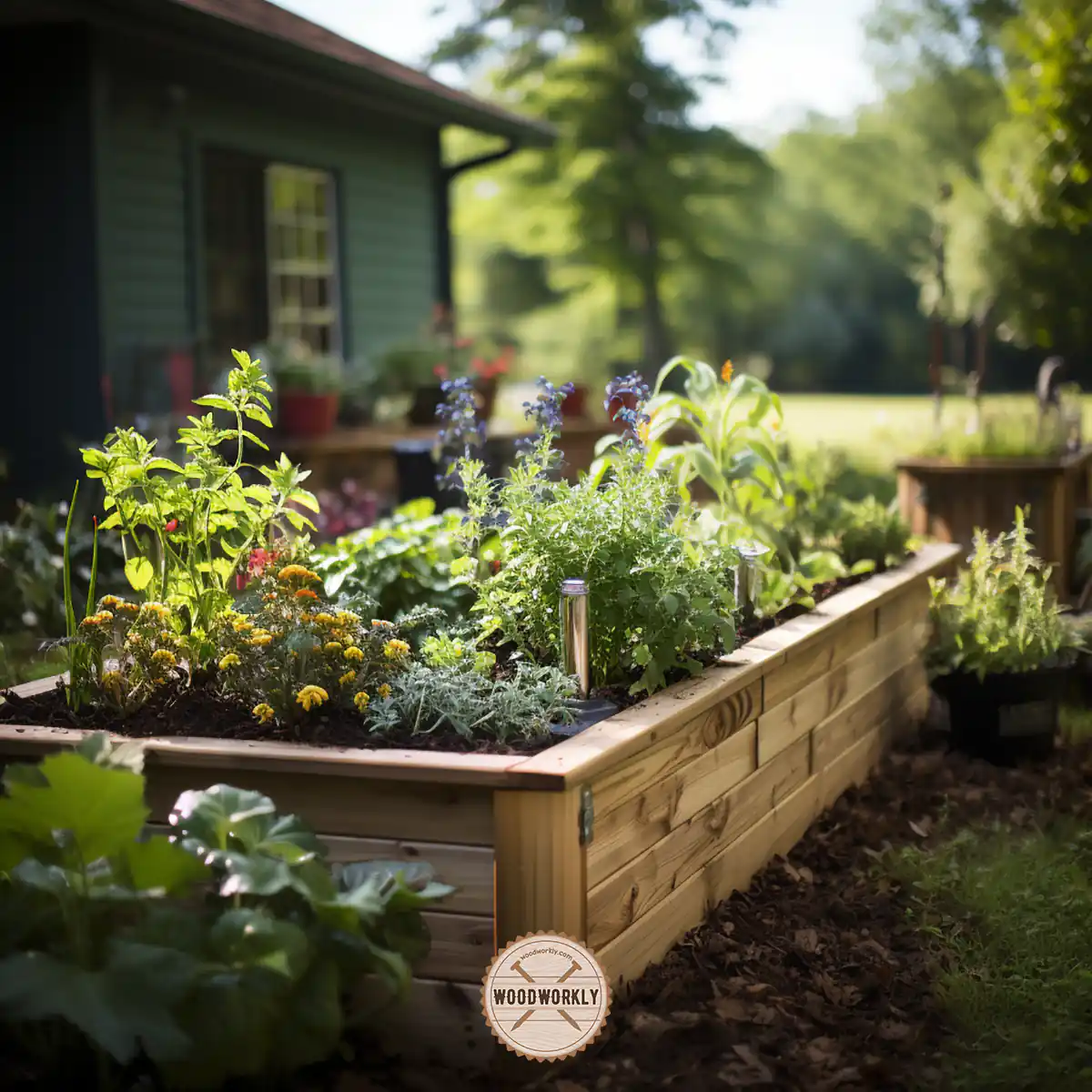
Pros and Cons Of Using Black Locust for Raised Garden Beds
Here’re the summarized pros and cons of Black Locust in making garden beds.
| Pros | Cons |
| Highly durable | Hard to work with |
| Decay resistant | |
| High strength |
As you can see Black Locust is wood with lots of advantages in making garden beds than disadvantages.
13. Black Walnut
Black Walnut is a great choice for garden beds. It is a dense wood with a lively surface texture and excellent processing qualities.
Carving, sanding, and finishing is so much easy with Black Walnut.
Here’re some useful qualities of Black walnuts in making garden beds,
- Resistant to fungi attacks
- High stability
Let’s discuss each of the above qualities in detail.
Resistant to Fungi Attacks
Black Walnut has a unique feature that is resistant to most fungi attacks. This makes it suitable for most outdoor woodworking projects.
Plus, it is resistant to insects as well.
High Stability
Black Walnut can fulfill one of the major requirements for being the best wood for garden beds by having great dimensional stability.
It warps only slightly and lasts longer over a decade.
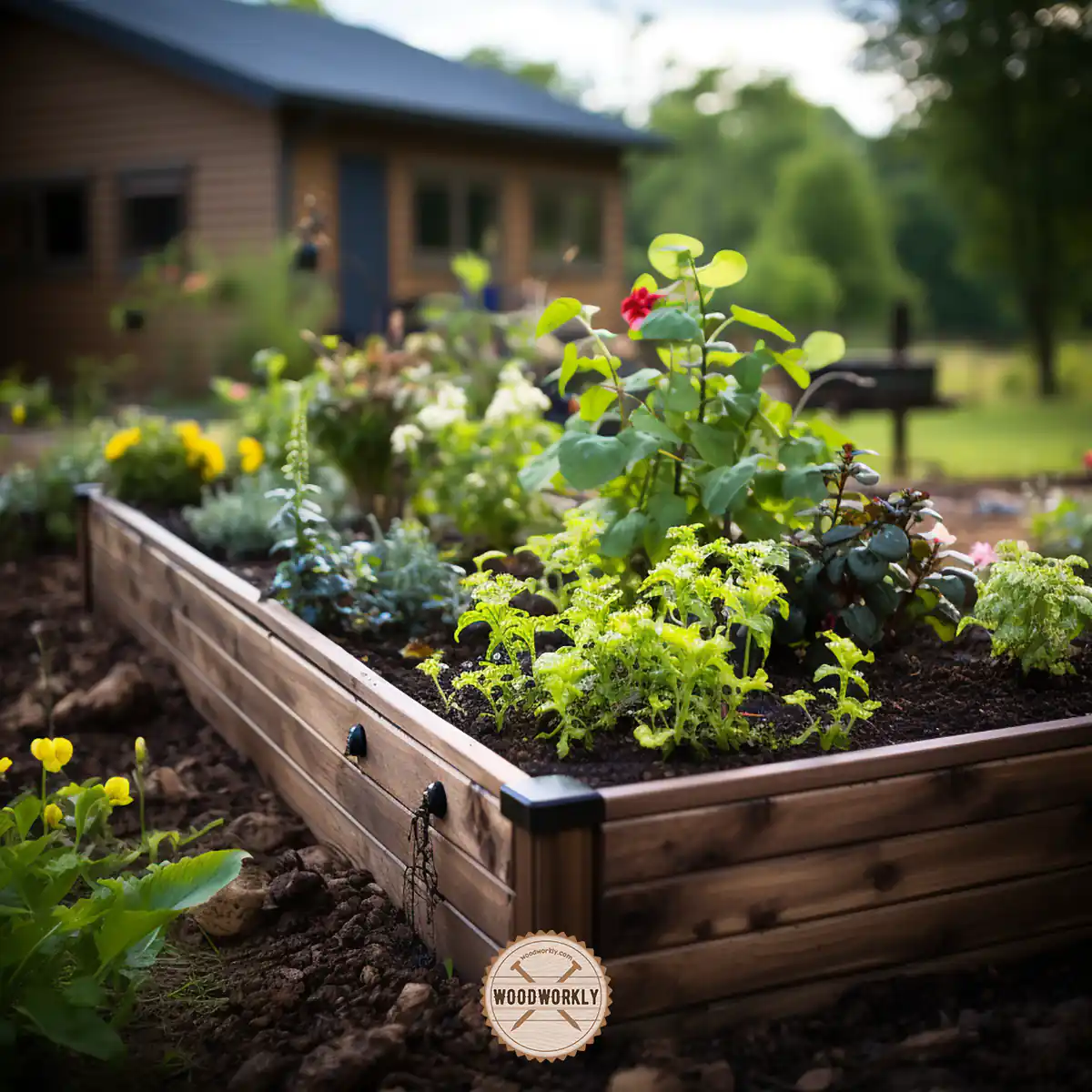
Pros and Cons Of Using Black Walnut for Raised Garden Beds
Here’re some pros and cons of Black Walnut which are useful in making garden beds.
| Pros | Cons |
| Easy to work with | No weather resistance |
| High stability | Expensive |
| High strength | Less availability |
| Resistant to fungi and insect attacks | |
| Aesthetic structure |
So, lets’ find out the specific features of the next best wood for garden beds, White Oak.
14. White Oak
White Oak is a good material for garden beds with natural rot resistance and it is 50% to 100% stronger than the woods like Pine.
It is heavy and filled with lots of exceptional qualities.
Here’re are some qualities of White Oak that are useful in making garden beds,
- Beautiful grain
- Highly durable
- Rot resistant
Let’s discuss each of the above qualities in detail.
Beautiful Grain
White Oak has a beautiful grain which makes your garden beds more attractive.
The natural texture of White Oak does not ruin by applying stain or any other transparent finisher.
It’ll still have a lot of character.
Highly Durable
White Oak is considered one of the most durable and strong wood types that can use for garden bed making. It is resistant to dents and scratches.
Rot-resistant
White Oak is less favorable to warp and resistant to rotting and many other environmental elements.
Therefore, White Oak can use for any outdoor woodworking project with ease. Garden beds made of White Oak last over a decade or two.
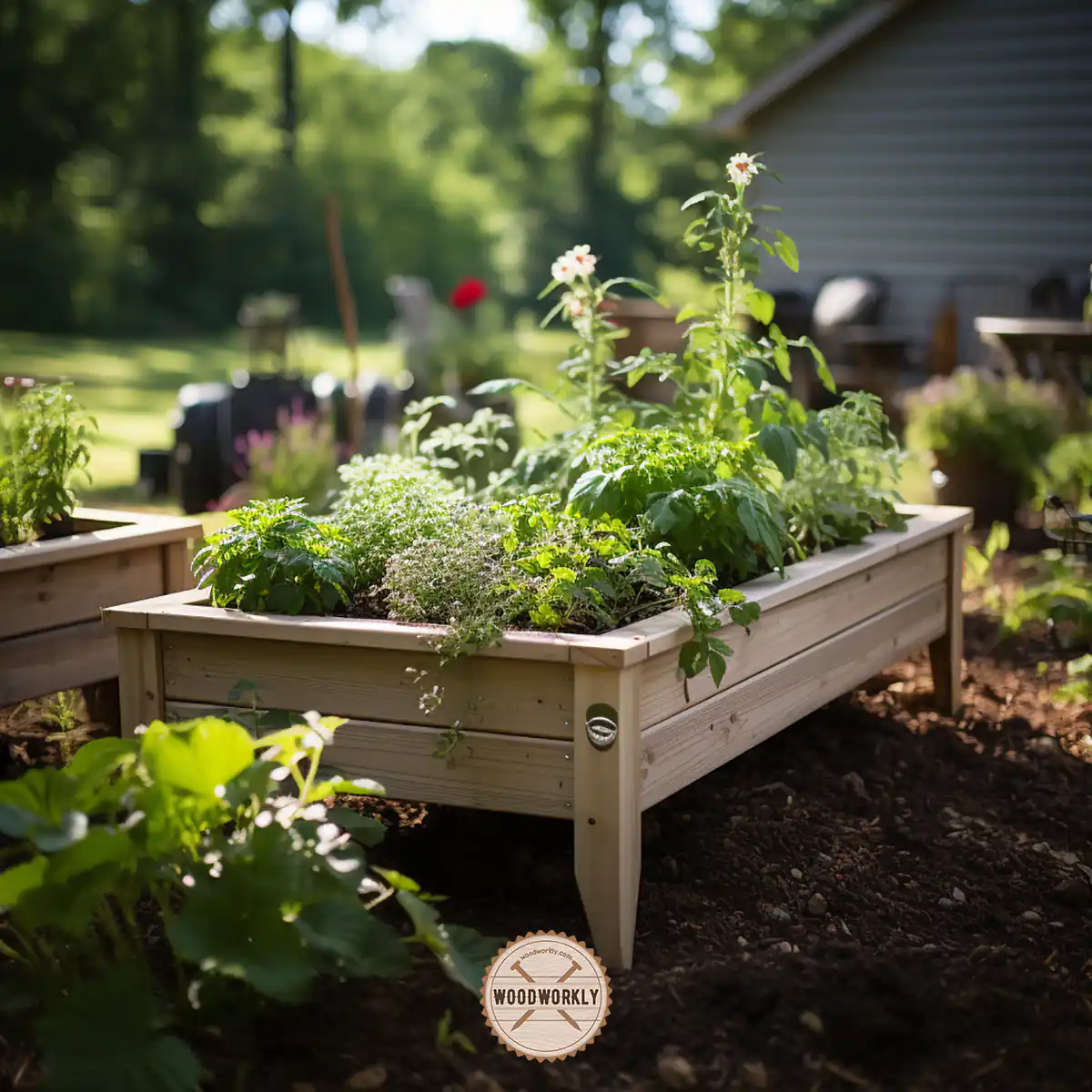
Pros and Cons Of Using White Oak for Raised Garden Beds
Here’re the pros and cons of White Oak which are useful in making garden beds.
| Pros | Cons |
| Attractive texture | Expensive |
| High durability | Heavy and hard |
| Can get any color you want by spraying without destroying its natural beauty | Zero thermal resistance |
| High water resistance | |
| Easy to stain |
As you can see White Oak gives the luxurious look to your garden beds and you’ll feel proud about the final outcome. This makes it one of the best wood for garden beds.
15. Pressure-Treated Wood
You know, when I first started dabbling in gardening, there was this constant chatter amongst my green-thumbed friends about ‘pressure-treated wood.’
I remember thinking, “What on earth could that mean?” Well, soon enough, as I dived deeper into backyard projects, I came to understand and appreciate this wonder of wood.
Pressure-treated wood is essentially lumber that has undergone a special treatment process to protect it from rot, decay, and termite damage.
Think of it as giving the wood a superhero shield against the forces of nature. And the process? Oh, it’s as fascinating as it sounds.
They take the wood and place it in a large cylindrical tank.
All the air is removed, creating a vacuum, and then a preservative solution is forced into the wood under high pressure. Hence, “pressure-treated.”
Now, you might wonder why I’d ever consider using it for my garden beds.
Well, gardening isn’t just about planting seeds and watching them grow.
It’s also about ensuring that the beds where you plant these seeds remain sturdy and durable. And that’s where pressure-treated wood shines.
Why is pressure-treated wood good for garden beds?
Remember those superhero shields I mentioned earlier? Gardens are exposed to elements – rain, wind, pests, and more.
So, you want something that can resist rot, especially if you’re in an area with a lot of rainfall.
Now, here’s a quick story for you: My neighbor once built a garden bed with regular wood.
It looked fabulous for the first season.
Come the second year, after a particularly wet winter, the wood started showing signs of rot, and by the third year, it was a mushy mess.
All his hard work down the drain. Had he used pressure-treated wood, that story might have had a different ending.
Qualities of pressure-treated wood that make it suitable for garden beds:
- Durability: Unlike regular wood, it can last for decades without showing significant wear and tear.
- Rot-resistant: Thanks to the preservatives, this wood is less likely to decay, ensuring your garden beds remain intact for longer.
- Pest deterrent: The treatment deters pests like termites, which can be a real nightmare for garden beds.
- Cost-effective: In the long run, even if it might seem a tad pricier initially, it saves you from frequent replacements, making it a cost-effective choice.
- Low maintenance: Once set up, you don’t have to constantly worry about treatments or upgrades. A quick check and maybe a wash every now and then, and you’re good to go!
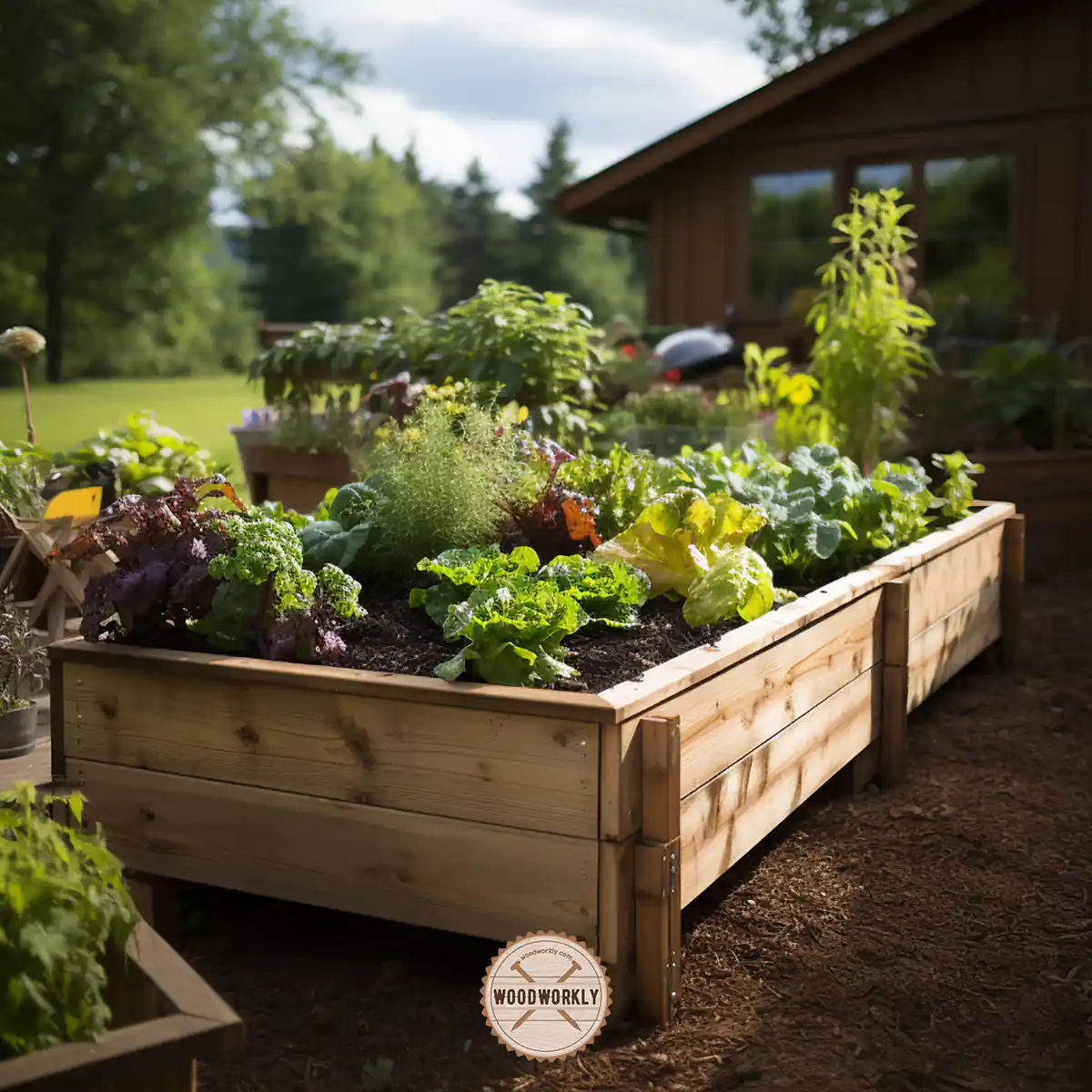
Pros and Cons Of Using Pressure Treated Wood for Raised Garden Beds
| Pros | Cons |
|---|---|
| Durability | Potential chemical leaching |
| Rot-resistant | Might be more expensive initially |
| Pest deterrent | Appearance may change over time |
| Cost-effective in the long run | Concerns about food safety (for edible crops) |
| Low maintenance | Limited natural wood aesthetics |
Woods To Avoid for Raised Garden Beds
- Recycled woods
- Reclaimed woods
- Old woods
- Old pressure-treated woods
Congrats folks! Now you know bets wood for raised garden beds with the qualities of each wood. Plus, I’ve mentioned pros and cons of each wood as well.
So, let’s answer some frequently asked questions.
FAQs
Are there chemicals in pressure-treated wood that could harm my plants?
Older pressure-treated wood used arsenic, which raised concerns. However, most pressure-treated wood today uses safer preservatives, but always check the type and origin before using it in your garden.
Is composite lumber suitable for raised beds?
Composite lumber, made from wood fibers and recycled plastic, is a durable and almost maintenance-free option. Just be sure it doesn’t contain harmful chemicals if you’re growing edibles.
How often should I replace the wood of my garden beds?
The longevity of your garden bed wood depends on the type and treatment. For instance, cedar can last 10-15 years, while pressure-treated wood can serve even longer.
Can I use reclaimed wood for my garden beds?
While reclaimed wood adds character, ensure it hasn’t been treated with harmful chemicals or exposed to contaminants, especially if you’re planting edibles.
Should I line the inside of my wood garden beds?
Lining can help protect the wood from moisture and prolong its life. Using a porous landscape fabric can be an effective way to keep the soil in and let excess water out.
What’s the most eco-friendly wood choice for garden beds?
Choose woods like sustainably sourced cedar or redwood. Also, look for wood with certifications like FSC (Forest Stewardship Council) to ensure it’s sustainably harvested.
Is it necessary to treat or seal my wooden garden beds?
While not mandatory, sealing or treating can extend the wood’s lifespan. Just ensure any treatments are safe for plants, especially edibles.
Did I cover all you wanted to know about: Best Wood for Raised Garden Beds
In this article, I have deeply discussed the best wood for garden beds by taking 15 wood types.
I have talked about the special character features of each wood with their advantages and disadvantages in making raised garden beds.
The best wood for raised garden beds is cedar due to its natural rot-resistance and durability. Other excellent choices include redwood and pressure-treated wood, which offer longevity and sturdiness. Always ensure that the wood is safe for growing edibles if that’s your intent.
Ultimately, my advice is all 15 wood types that are discussed in this article are great to make garden beds.
But you should always focus on the preparation and finishing parts of the process.
For example, even though wood is weather-resistant, you should apply a good sealer to protect from outdoor elements. Because no wood has 100% resistance for anything.
Also, I have answered frequently asked questions as well.
I hope by reviewing each wood one by one, now you can get an idea or take the final decision of your personal choice to select the best wood for garden beds with ease.